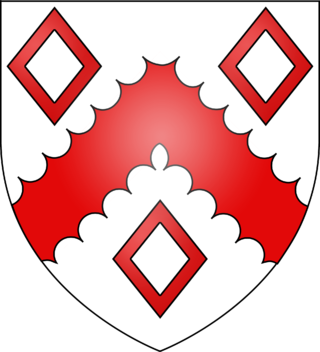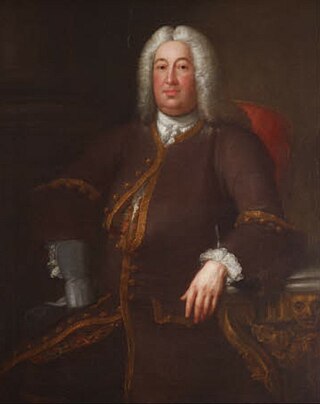
Marquess of Bristol is a title in the Peerage of the United Kingdom held by the Hervey family since 1826. The Marquess's subsidiary titles are Earl of Bristol, Earl Jermyn, of Horningsheath in the County of Suffolk (1826), and Baron Hervey, of Ickworth in the County of Suffolk (1703). The Hervey barony is in the Peerage of England, the earldom of Bristol in the Peerage of Great Britain and the Jermyn earldom in the Peerage of the United Kingdom. Earl Jermyn is used as courtesy title by the Marquess's eldest son and heir. The Marquess of Bristol also holds the office of Hereditary High Steward of the Liberty of St Edmund. The present holder of these titles is Frederick Hervey, the 8th Marquess and 12th Earl of Bristol.

Henry Jermyn, 3rd Baron Jermyn and 1st Baron Dover, 1st Jacobite Earl of Dover PC was an English courtier, peer and favourite of James II.

Hardwick House was a manor house near Bury St Edmunds, Suffolk, owned by Sir Robert Drury, Speaker of the House of Commons, of Hawstead Place. It was subsequently purchased in the seventeenth century by Royalist Robert Cullum, a former Sheriff of London. Experts in Suffolk county history as well as noted authorities in antiquarian and botanical matters, the Cullum family of eight successive baronets authored works on the county and its fauna and flora. Sir Thomas Gery Cullum, a Charterhouse graduate, medical doctor and member of the Royal Academy and the Linnean Society, was a well-regarded author on science and botany.

The Spring family is a Suffolk gentry family that has been involved in the politics and economy of East Anglia since the 15th century, as well as holding large estates in Ireland from the 16th century.

Horham Hall may refer to the timber-framed late mediaeval hall in Thaxted, England, or to the brick hall built in its place by Sir John Cutte in the early 16th century.
Sir William Spring of Lavenham was an English politician and landowner.

Sir Thomas Spring, 3rd Baronet of Pakenham Hall in Pakenham, Suffolk, was an English baronet and landowner who served as High Sheriff of Suffolk in 1696.

Sir Thomas Jermyn (1573–1645) of Rushbrooke, Suffolk, was an English courtier and Royalist soldier who served as a Member of Parliament between 1604 and 1640.

Thomas Jermyn, 2nd Baron Jermyn was an English politician who sat in the House of Commons from 1679 until he inherited a peerage in 1684.
Sir Robert Jermyn DL (1539–1614) was a prominent East Anglian landowner and magistrate, of strongly reformist views in religion, who sat in the House of Commons at various times between 1584 and 1589.
Hoxne manor is an estate in Hoxne, Suffolk, England. It was originally a manor house belonging to East Anglian bishops. However following the dissolution of the monasteries, the land was handed over to favourites at the court of Henry VIII.

The Davers Baronetcy, of Rougham in the County of Suffolk, was a title in the Baronetage of England. It was created on 12 May 1682 for Robert Davers, who had made a great fortune in Barbados as a plantation owner before acquiring the Rougham estate in Suffolk. The second and fourth Baronets represented Bury St Edmunds and Suffolk in Parliament. The sixth Baronet sat as Member of Parliament for Weymouth and Bury St Edmunds. Despite having an alleged nine illegitimate children, the 6th Baronet left his estates to his nephew, Frederick Hervey, 1st Marquess of Bristol, and his baronetcy became extinct.
Sir William Hervey was an English politician who sat in the House of Commons at various times between 1624 and 1629.

Sir Edward Lewknor or Lewkenor was a prominent member of the puritan gentry in East Anglia in the later Elizabethan period, and an important voice on religious matters in the English Parliament.

Sir Robert Davers, 2nd Baronet, of Rougham and Rushbrooke Hall, was an English politician, landowner and slavetrader.

Sir Ambrose Jermyn of Rushbrooke, Suffolk, was an English courtier, magistrate and landowner.

Sir Jermyn Davers, 4th Baronet, of Rougham and Rushbrooke, Suffolk, was an English landowner and Tory politician who sat in the House of Commons from 1722 to 1743.

Sir Charles Davers, 6th Baronet was a British Army officer and politician who sat in the House of Commons from 1768 to 1802.
Pakenham Hall was a manor house in Pakenham, Suffolk, the capital residence of Pakenham manor. It was demolished and replaced by a more modern house, now called Pakenham Old Hall, in 1900. It was the family seat of the Spring family between 1545 and 1735, and then of the Barons Calthorpe.

Wolseley Hall was a stately home near the village of Colwich, in Staffordshire, England. It was demolished in 1966; the former gardens are now a nature reserve of the Wolseley Centre.

















